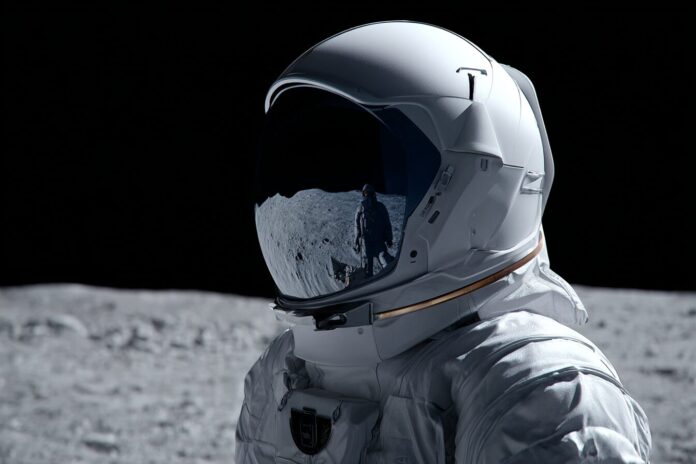Lunar Exploration Meets Optical Innovation
As humanity prepares to step back onto the lunar surface, the need for cutting-edge technology becomes paramount. Most importantly, astronaut safety and performance must be ensured in an environment filled with extreme light, intense radiation, and abrasive lunar dust. Because these challenges require innovative solutions, NASA has partnered with Oakley, a renowned leader in eyewear innovation, to design a state-of-the-art visor for the next generation lunar spacesuit.
Furthermore, this collaboration is set to redefine the boundaries of optical engineering in space. The integration of advanced materials and protective coatings not only provides superior vision but also ensures durability. The partnership between NASA and Oakley is a perfect example of leveraging expertise across industries to overcome the harsh conditions of space, as detailed in sources such as TechSpot and Space Launch Schedule.
The Next-Gen Spacesuit: AxEMU
The Axiom Extravehicular Mobility Unit (AxEMU) represents the forefront of spacesuit design, tailored specifically for NASA’s Artemis missions. Because these missions aim to explore the lunar south pole and beyond, every component must be engineered for the unexpected. Axiom Space is leading the charge with the overall suit design, while Oakley focuses on the visor system that astronauts rely on for both safety and clarity.
In addition, scheduled for mid-2027 during the Artemis III mission, the AxEMU spacesuit marks the first crewed lunar landing since Apollo 17 in 1972. This milestone is both historic and challenging. Therefore, integrating a robust visor system that adjusts to the Moon’s extreme lighting environments is not just innovative—it is indispensable for mission success. More details on the scope of this partnership can be found on CollectSpace.
Oakley’s Engineering Breakthrough
Oakley combines decades of optical research with innovative design philosophies to handle the unique challenges of space exploration. Most notably, its High-Definition Optics (HDO) technology, originally perfected in competitive sports eyewear, has been optimally adapted for the lunar environment. By minimizing glare and enhancing contrast, this technology plays an essential role in ensuring precise vision even under extreme light conditions.
Besides that, Oakley’s visor boasts a two-part deployable design that adjusts instantly to changing light intensities. In addition, a secondary helmet bubble offers supplementary protection, and multiple specialized coatings shield the visor against fine regolith and micro-impacts. These engineering feats are highlighted on the Axiom Space website, underscoring the meticulous detail put into each component.
Protecting Vision on the Moon
Because the Moon’s environment is characterized by unfiltered sunlight and extreme shadows, managing light and glare becomes crucial. The visor integrates a 24-karat gold coating renowned for its reflective properties. Most importantly, this coating not only reflects intense sunlight to diminish glare but also filters out harmful ultraviolet rays, offering enhanced safety compared to Earth-bound conditions.
Moreover, the gold coating coupled with advanced multi-layered surface treatments ensures that the visor remains crystal clear despite the abrasive lunar dust. This dust, composed of fine particles similar to glass, can severely impair vision if not properly mitigated. As such, the technology behind Oakley’s visor is both innovative and essential for preserving astronaut eyesight, as confirmed by recent developments reported on Space Launch Schedule.
Collaborating for Astronaut Safety
The joint venture between Axiom Space and Oakley is not merely a commercial partnership—it signifies a pivotal advancement in public-private collaboration. Because astronaut safety is of utmost importance, combining the realms of aerospace engineering and high-performance eyewear has unlocked new opportunities. This approach redefines the relationship between design and functionality in extreme conditions, where every detail matters.
Furthermore, by merging the expertise of both industries, the visor system represents a breakthrough in interface design for spacecraft. As highlighted by Oakley’s SVP of Advanced Product Development, Ryan Saylor, this development results from decades of relentless innovation. Such a partnership not only imparts improved contact between the astronaut and their environment but also ensures that vision remains reliable across all mission scenarios. Additional insights into this collaboration can be found via Ground News.
Setting a New Benchmark for Space Technologies
Because innovation is driven by necessity, the next-gen visor system is set to become a benchmark for future space missions. The visor delivers enhanced contrast and protection, ensuring that astronauts encounter minimal visual interference. Most importantly, it facilitates safe and effective operations in conditions that were once deemed impossible to overcome.
In addition, this breakthrough illustrates how cross-industry expertise can foster deeper advancements in technology. The superior optical clarity and robust protective measures have been engineered to meet the rigorous demands of lunar exploration. Therefore, with innovations such as Oakley’s visor, astronauts are better equipped for the extreme challenges presented by the lunar landscape. This progress not only paves the way for safer missions but also inspires future technological endeavors in space exploration.
Conclusion
Ultimately, Oakley’s advanced visor system for NASA’s next lunar spacesuit is a triumph of design and technology. It expertly combines adaptive optics, protective coatings, and innovative engineering to safeguard vision under unprecedented conditions. Because both safety and clarity are critical in space, the continual evolution of such technologies promises a new era of exploration where human capabilities are significantly enhanced.
As space exploration edges into a new frontier, each innovation reinforces the necessity for rigorous design and proactive solutions. With partnerships like that between NASA, Oakley, and Axiom Space, the future of lunar exploration stands brighter and safer than ever before.
References
- TechSpot: Oakley designing the visor for NASA’s next lunar spacesuit
- CollectSpace: Oakley to provide visors for Axiom Space’s AxEMU spacesuit
- Axiom Space: Engineered for Astronauts – Next-Gen Visor System
- Space Launch Schedule: Axiom Space and Oakley Partnership on Visor
- Ground News: NASA Artemis II Moon Mission Updates



